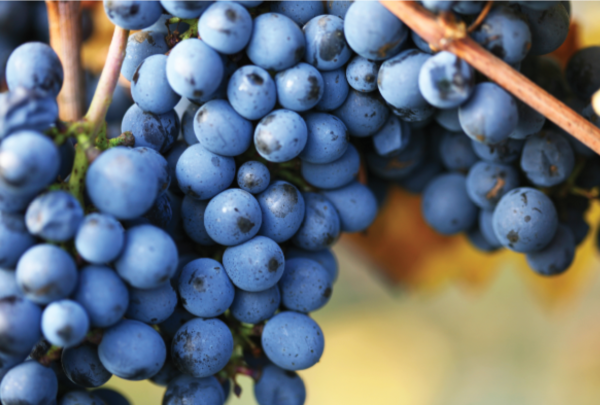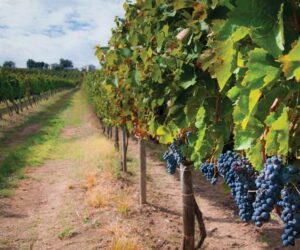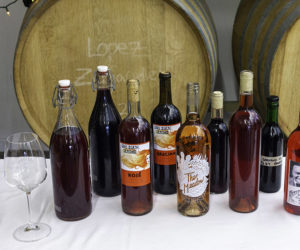 Pinot at a Glance
Pinot at a Glance
Pinot Noir is a heralded red table wine. It is usually made in a dry style that features delicate fruit aromas and flavors. The wine typically has a light to medium body. Pinot Noir is a challenging wine to make.
When talking to winemakers about Pinot Noir, the conversation quickly becomes a love-hate thing. Pinot Noir does that to people; it makes them emotional. The grape is difficult to grow and the wine is even tougher to make. But when it is good, it is memorable.
Despite its inconsistent performance, Pinot Noir has been planted in every cool grape-growing region in the world. In cooler climates, the vine will not mature early. This is good, because when Pinot ripens too soon, it loses its aroma and acidity. Pinot Noir seems best-suited to limestone and sandy soil. Damp, low-lying regions do not work well with this persnickety grape.
Pinot Noir is tough to work with under the best of geographic conditions. It tends to bud early and is vulnerable to early spring frosts. The skins of the Pinot Noir are thin and the grape is prone to viruses, particularly leafroll and fanleaf.
Fine Pinot Noir wines from the Burgundy region of France may range in color from pale red to deep ruby and display complex aromas of mushrooms, truffles, musk, rose petals and wild berries. The tannins can be silky, soft and pleasant, while acidity adds crispness. Mature Pinot Noir wines often display a variety of flavors and aromas, including figs, violets, chocolate and prunes. French wine lore holds that the better the Pinot Noir wine, the more difficult it is to describe.
Pinot history and plantings
Pinot Noir is an ancient varietal; it is believed to have been cultivated from wild vines at least two thousand years ago. Historical records prove that Pinot was grown during the fourth century A.D. in France.
Pinot Noir is still considered in Burgundy to be the best of the reds. It is also popular in the Champagne region, one of the coldest grape-growing regions in the world, where it is used in many of the great sparkling Champagnes. Pinot Noir plantings in France now total 55,000 acres, from the Côte d’Or to the Alsace.
In Germany some 13,500 acres of Pinot Noir (Spatburgunder) are planted, sixty percent more than a decade ago. Most German vintners are making Pinot Noir in the Burgundian style. It is deep-colored, dry and well balanced.
California has had inconsistent results with Pinot Noir, mostly because the first vineyards were planted in regions that are too warm. Cool California regions like Carneros, Russian River, San Benito and Santa Maria have proven more successful. Some 15,000 acres are now planted and acreage is increasing each year.
Oregon has become the hottest location in the New World for Pinot Noir. Several French winegrowers have purchased land in Oregon; they are planting Pinot and making the wine there. As the vines have matured and Oregon’s vintners have honed their techniques, their Pinot Noir wines have earned international acclaim.
Making Pinot Noir at home
Until the early 1990s, home winemakers were hard-pressed to buy good Pinot Noir grapes from California — or from anyplace else. Since then, the quality and availability of this winegrape has increased tremendously. Excellent Pinot Noir kits and concentrates are easy to find these days, too.
In earlier years, Pinot Noir had a bad reputation among home winemakers. It was considered finicky, and in the hands of amateurs it produced light, tasteless and simplistic wine.
Despite all the improvements to the variety, producing an outstanding Pinot Noir remains a challenge for both the commercial and amateur winemaker. For many, that is precisely the appeal.
Pinot Noir winemakers have been experimenting with a wide variety of techniques in recent years. One of the most successful is the “cold soak” method. After the grapes have been de-stemmed, crushed and placed in the fermentation container, a dose of potassium metabisulfite (30 ppm) is added to protect the Pinot Noir from bacteria and premature fermentation. The must is then covered and chilled to 50° F (10° C) for three days. This allows the anthocyanin pigments to separate from the skins, which will produce a deeper-colored wine.
There are various ways to keep the must cool; one of the more popular techniques is putting ice in clean plastic sacks and lowering it into the must. With the addition of the metabisulfite and the ice, fermentation cannot begin, which is the plan. Stir the must twice a day for three days to thoroughly mix the juice and color compounds. Warm the fermentation container on the fourth day and when the must is tepid (65–70° F or 19–21° C) inoculate to begin fermentation. This procedure produces a wine with deeper colors and more intense flavors.
I have enjoyed the challenge of making Pinot Noir and the variety has now become one of my favorites. When made properly the wine is elegant and refined. Coupled with lamb, veal or roasted chicken, Pinot can reach new heights of sophistication. Although most of the Pinot Noir made in France is 100 percent varietal, I have found that it blends well with other wines, particularly Syrah, Petite Sirah, Merlot, Cabernet Franc and Cabernet Sauvignon.
The three most popular yeast strains used for Pinot Noir are Wyeast Bordeaux (3028), Red Star Premier Cuvée and Wyeast Assmannhausen (3277). The Wyeast Bordeaux produces wine with an intense berry and graham-cracker nose and a jammy, complex profile. Red Star Premier Cuvée yeast ferments over a wide temperature range and imparts a subtle citrus flavor. The Assmannhausen is a slow-fermenting strain that lends an austere fruitiness to the wine.
Because Pinot Noir has a lighter color than other reds, some winemakers are leaving the wine on the skins a little longer. Some leave the wine on the grape skins for three weeks or longer to achieve maximum color and complexity in the finished wine.
Another technique I have successfully used with Pinot Noir grapes is to crush twenty percent of the grapes and then press them right away. I make that batch into a white wine, then return the crushed grapes to the red wine batch, thereby giving the red batch more color and complexity. This simple process, which is used by many commercial winemakers, is called “saignier” by the French.
Red Wine from Pinot Noir Grapes
Yield: 5 gallons (19L)
Ingredients
60–75 pounds (27–34 kg) grapes
20 drops (1 ml) pectic enzyme liquid
12 Campden tablets or 1 to 1-1/2 teaspoons (6.2–9.3 g) potassium metabisulfite powder
1 package (5 g) Wyeast Bordeaux (3028), Red Star Premier Cuvée or Wyeast Assmannhausen (3277) yeast
3 teaspoons (8.8 g) yeast nutrient
3 tablespoons (11.1 g) Oak-Mor
1 package malolactic culture
Step-by-step
1. Sanitize all equipment.
2. Remove any spoiled grapes from the clusters and then crush the grapes. Add 20 drops (1 ml) of pectic enzyme liquid to the crushed grapes and juice.
3. Add 3 crushed Campden tablets or 1/2 teaspoon (3.1 g) of potassium metabisulfite powder. Stir the juice and crushed grapes and let sit overnight.
4. The second day, test for sugar and acid and make appropriate adjustments. Ideal sugar should be 21–24° Brix and acid range should be from 0.6 to 0.9 percent.
5. Make a yeast starter by pouring 4 ounces (120 ml) of grape juice and 4 ounces (120 ml) of lukewarm water into a bowl. Sprinkle in the yeast and the yeast nutrient and let proliferate for 30 minutes. Add the starter and the Oak-Mor to the must and stir well. Cover the container with a sheet of clean plastic.
6. Fermentation will start in 2 or 3 days and continue for 7 to 12 days. The must temperature must be at least 60° F (16° C) and no more than 75° F (24° C). Temperatures exceeding the maximum recommended temperature might cause a stuck fermentation. The cap (the pulp, skins and other solids) will rise to the top, so twice daily push it down with a sanitized spoon. This allows the color and body to be extracted from the skin and pulp.
7. Between the fourth and sixth day, inoculate the must with the malolactic culture according to the manufacturer’s instructions. Exactly when to inoculate wine with a specific ML culture is a complex question that generates much debate. Most ML cultures like the temperatures to be above 65° F (18° C) and are not highly tolerant of SO2. Again, follow the instructions.
8. Monitor the wine each day with a hydrometer. When the specific gravity goes below 1.000, it’s time to press out the wine and store it in another container.
9. Sanitize a 5-gallon (19 L) glass carboy. Put in three crushed Campden tablets or 1/4 teaspoon (1.6 g) potassium metabisulfite powder. Siphon the must into the carboy and fill up to the top. Insert a rubber bung and an airlock into the jug opening.
10. Let the wine sit 3 to 4 weeks, then rack it again into a sanitized carboy after adding 2 crushed Campden tablets or 1/8 teaspoon (0.7 g) of potassium metabisulfite powder, leaving the sediment behind in the previous carboy. Two to four more rackings, about 4 to 6 weeks apart, should pace the wine perfectly to its finish.
11. The wine should clear itself. If it doesn’t, wait longer and rack until the wine clears.
12. When the wine is clear, it’s time to bottle the batch. Make adjustments if needed, then bottle the wine and wait at least 6 months before tasting.






